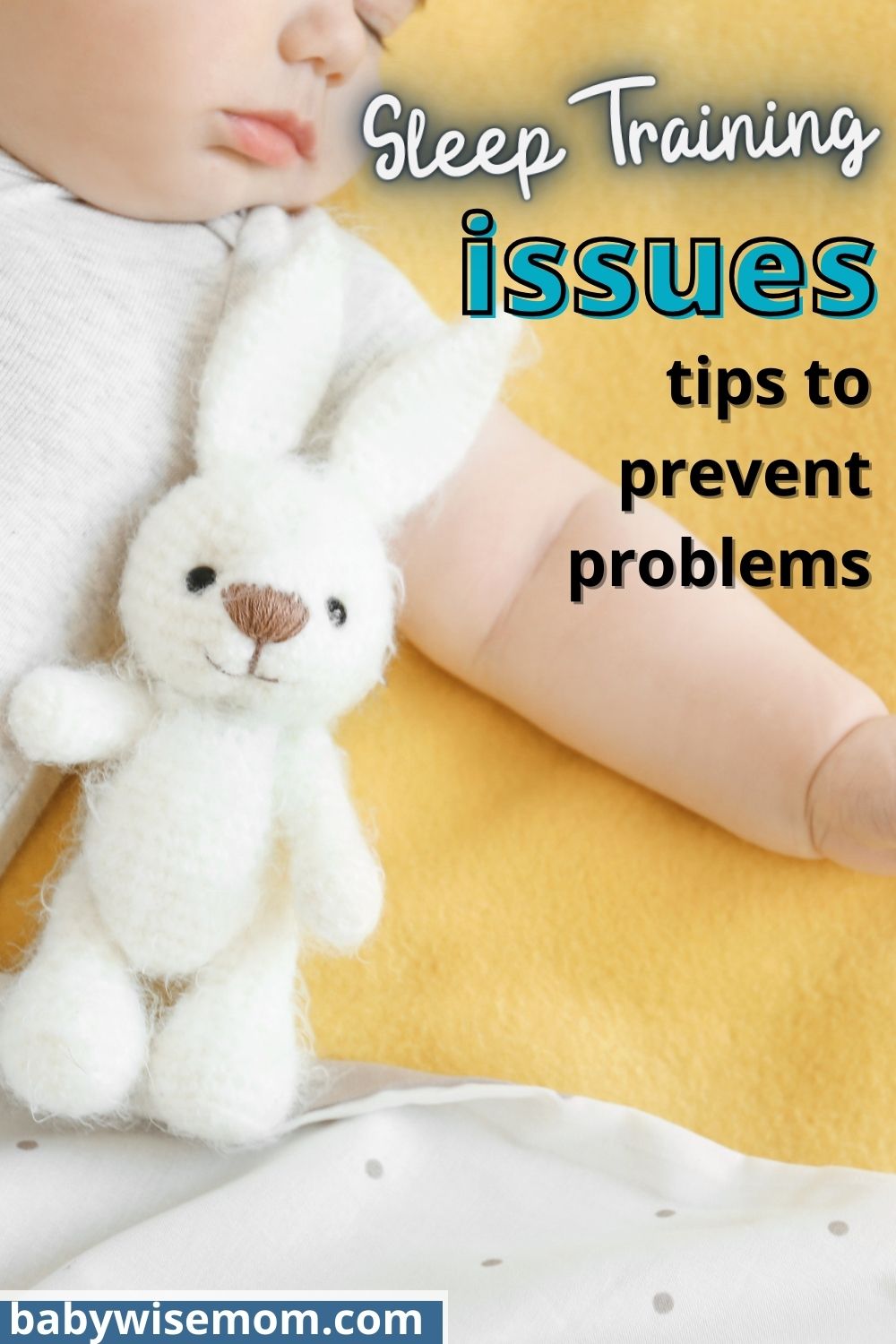As you start sleep training your baby, you will want to prevent sleep training issues. Learn about 6 common sleep training problems and how you can prevent them and help your baby have sleep training success.

Sleep training a baby is not easy. It is physically and emotionally exhausting and requires a lot of your mental effort as you work to make sure your baby can have success.
There are a lot of issues that can come up while sleep training. There can be a lot of disruptions that interfere with your sleep training success. Let’s talk about common issues parents face when sleep training infants and how you can prevent them from being a problem.
Post Contents
- Diaper Leaks Wakes Baby Up
- Change the Diaper Right Before Sleep
- Size Up
- Nighttime Diaper
- Use a Diaper Booster Pad
- Noises in the Home Disrupts Baby’s Sleep
- Baby’s Sleep Schedule is Sporadic
- Can’t Find a Sleep Training Method that Works
- Baby Just Won’t Fall Asleep Independently
- Wake Windows During Daytime
- Stimulation Levels
- Catnaps
- Sleep Routines
- Hard to Sleep Train Baby when Sharing a Room
- Conclusion
- Related Posts
Diaper Leaks Wakes Baby Up
After working so hard to get your baby to learn to fall asleep independently, it can be incredibly frustrating to have something like a diaper leak wake your baby up. Fortunately, there are a few things you can do to prevent this from being a sleep problem.
Change the Diaper Right Before Sleep
It is good practice to have a diaper change be part of your nap routine and your bedtime routine. Put baby in a fresh, dry diaper any time you are putting her down for sleep.
Size Up
If you still have problems with diaper leaks even with a fresh diaper, consider sizing up. This is most commonly needed for night sleep if you have night wakings due to a leaky diaper.
Sizing up can definitely work, but take note that it si less successful with newborns than with older babies. Newborns are just so small that sizing up can just end up leaving big gaps for the urine and poop to come out of. So your baby won’t leak because the diaper is too full, but will still leak because there are gaps in the diaper. This can also be an issue if your baby is just barely big enough for her current diaper size.
Nighttime Diaper
A nighttime diaper is a really good idea for your baby’s night sleep. Overnight diapers are extra absorbent and can typically keep baby dry for up to 12 hours. They are usually more expensive than regular diapers.

Use a Diaper Booster Pad
Another great option is to use a diaper booster pad. I really wish these were a thing when my kids were babies and even a toddler.
Sposie is an absorbent booster pad designed to stop diaper leaks. They are super absorbent diaper inserts. You just place it inside the diaper to help collect the moisture. It keeps baby’s skin dry and rash free!
They come in sizes from newborn up to 5T and even a “Super Sposie,” so you can rely on these for as long as you need to.
This is really handy when you have a baby who is too small to size up but the diaper she is in just cannot handle the amount of pee she has during the night.
Noises in the Home Disrupts Baby’s Sleep
No one wants to face mom when they have woken the baby up. We want “baby to join the family.” We want the other kids and adults in our homes to be able to move about the house as usual.
But we also want baby to sleep.
As baby moves between sleep cycles, he will be in a very light stage of sleep. That means sounds, smells, and sights can easily pull baby into an awake and alert phase rather than moving into the next sleep phase.
If you have trouble with noises waking your baby up, use a white noise machine. Read more here: Benefits of White Noise for Baby Sleep
Baby’s Sleep Schedule is Sporadic
It can be really hard to be successful with sleep training if your your baby’s sleep schedule is sporadic. If you have no idea when your baby will wake up each day, when naps will happen, and/or when bedtime will happen, you need to get some consistency to your days.
While you are sleep training your baby, you need to have super consistent days and have a very consistent daily routine. You are building a foundation. You will not be tied to your home long term, but right now while you are sleep training your baby, this sleep training needs to come first.
Clear your calendar for two weeks. Do not commit to be anywhere. Do not have appointments. Do not have lunch dates. Do not plan to leave your house unless you can do so without your baby.
Wake your baby up at the same time each morning. Have naps at the same time each day. Have feedings at the same times. Follow an eat, then play, then sleep pattern each day. Have a consistent bedtime each night.
>>>Read: Tricks for Getting Baby on a Consistent Schedule
Can’t Find a Sleep Training Method that Works
You may have jumped into the cry it out method only to decide your heart can’t take the tears. Maybe you are doing the Ferber method but the constant check-ins are wearing on your mental health. Perhaps you are concerned about hurting the bond and attachment with your baby no matter what sleep training method you use.
Before you start sleep training your baby, make sure you have researched different methods and have settled on one you feel comfortable with and are sure you can have success with. You do not have to listen to your child cry in order to sleep train.
There is not just one right way to sleep train. There are many that work. You just need to find what works best for your baby, you, and your family. All of the well-known methods out there work. Do your research and settle on one. There are many misconceptions tied to most different ways of sleep training. Make sure you get the pros and cons of each method so you can make an informed decision. Consult with your baby’s pediatrician if you need to.
Once you decide, you need to be committed. You can’t try a method for a day or two, then jump to another, then another. Give it time to work (unless you start it and realize it actually just will not work for your baby or you).
You also need to have consistency in your training. As I mentioned above, dedicate time to sleep training. Clear your calendar and give your baby time to get it.
Popular methods of sleep training to consider are:
- Fading Method (aka bedtime fading)
- Pick up / Put down
- 4 S’s
- Chair Method
- Ferber Method (aka Graduated Extinction)
- Cry It Out (aka CIO)
- Extinction Sleep Training
>>>Read: Sleep Training Methods: 7 different ways to train baby
Baby Just Won’t Fall Asleep Independently
If you are being consistent and your baby just cannot learn to fall asleep independently, there are many things to consider and address.
Wake Windows During Daytime
It is very important to understand wake windows when you are sleep training a baby. A wake window is the amount of time your baby is awake between naps. This period of time cannot be too long and it cannot be too short. Having a correct wake time length is also known as getting sleep pressure correct.
If your baby is awake too long or too short, your baby will struggle falling asleep independently. Longer periods of awake time will NOT lead to longer naps. It will do the opposite. Here are some helps for you to figure this out:
- How to Tell if Baby is Overtired vs. Undertired
- Optimal Waketime Lengths
- How Long Should a Newborn Be Awake Between Naps
- How To Accurately Calculate Baby Wake Time Length
Stimulation Levels
If you overstimulate your baby, you will cause infant sleep problems. You do not want to overstimulate your baby. This will cause sleep issues and your baby will struggle to fall asleep and stay asleep.
The same can be said for understimulating your baby. You really aren’t at risk of understimulating your baby until he is around 8 months old or older.
>>>Read: How To Calm Your Overstimulated Baby
Catnaps
Little catnaps can cause problems with sleep training. Catnaps can easily happen during a feeding and can also happen while driving in the car.
When your baby takes a catnap during what is supposed to be “wake time” or “play time,” you are disrupting that wake window we talked about above. Power naps affect you.
Keep your baby awake during feedings and in the car to have sleep training success.
>>>Read: Keeping a Newborn Awake During Feedings
Sleep Routines
Another important step to your sleep training success is to have solid sleep routine. A good sleep routine is a signal to your baby that it is time for a nap or bedtime. A consistent bedtime routine can make the difference between your little one falling asleep easily or struggling to settle down.
>>>Read: Sleep Routine Ideas to Get Your Baby Sleeping Well
Hard to Sleep Train Baby when Sharing a Room
It can be really hard to sleep train a child when they share a room. This can be true if your baby is sharing a room with his parents or with his older sibling. You will worry about your crying or fussing baby waking up a spouse or disrupting another child’s sleep. Everyone needs enough sleep, not just the baby.
It might be time to move your baby to their own room. There are also other things you can do that are more temporary just during the time of sleep training. Remember that sleep training does not last forever, so you can have people sleep in different locations during the training.
>>>Read: Managing Cry It Out While Room Sharing
Conclusion
Teaching your baby to self-soothe is an important step in establishing healthy sleep habits. Follow these tips to prevent sleep training issues and get your baby sleeping well!
Related Posts
- What Are the Benefits of Sleep Training?
- Best Baby Sleep Training Books to Get Baby Sleeping
- The Big List of Sleep Training Resources
- Gentle Sleep Training: The Four S’s
- Cry It Out Sleep Training Tips
- It’s time to take the guilt out of sleep training

